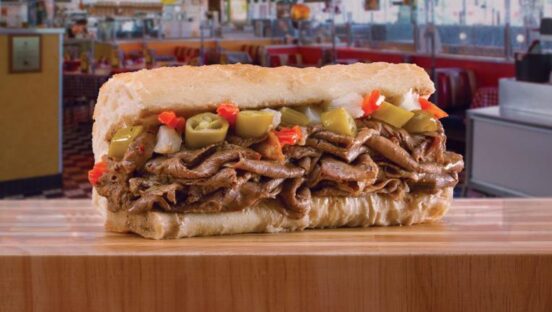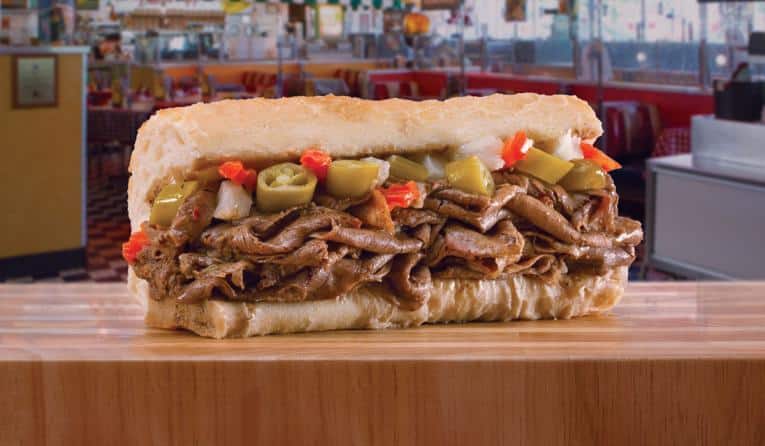Portillo’s CEO Michael Osanloo feels great about the chain’s 2022 class of restaurants—mainly because they keep outperforming expectations.
Look no further than the unit based in The Colony, Texas, which has earned $8.5 million in sales since opening in January; this location was planned in 2022 but only opened this year. The outlet is based in Grandscape, one of the biggest and fastest-growing mixed-use developments in the U.S.
“That’s not an annualized number,” Osanloo said during the brand’s Q2 earnings call. “That’s a year-to-date number. That’s feeding a lot of happy Texans.”
Stores in Tucson and Gilbert, Arizona, which are 2022 carryovers, too, debuted in February and March, respectively, and are earning average weekly sales comparable to mature units in the state. Also, the restaurant in Schererville, Indiana, which opened in November 2022, is generating AUVs similar to locations in Chicago, where the company was founded and is still headquartered.
Osanloo explained new units tend to have lower margins early on because of extra investments to ensure everything goes well, but the margin drag of the 2022 class has been lighter than projected.
He attributed success to better restaurant opening processes. Stores are now “training smarter, more efficiently, and for a shorter period of time,” Osanloo said. Portillo’s is pulling more resources at a quicker pace because the teams in place are more capable of handling it. A typical location has a general manager and assistant manager, and 60–70 percent of them worked up the Portillo’s system.
READ MORE:
Portillo’s Growth Potential is Even Greater than Once Imagined
Portillo’s Sees Future for To-Go Prototype, but Tweaks Are Needed
Portillo’s First Texas Unit is Earning $48K Per Day
The brand’s new restaurant opening team has the bandwidth to open three locations simultaneously and more than 30 stores annually.
“We learned to train folks on speed,” Osanloo said. “If you’ve worked in another fast-casual setting or a quick-service setting, a very, very busy hour might be $2,000, $3,000 an hour. Well, at Portillo’s, you’ll do $6,000, $7,000 lunch hour frequently. And so we train people on how to handle volume and speed and not buckle under the pressure. That’s been a light change difference in how our teams react to business, how they can handle it. They don’t get freaked out. People don’t get burned out as quickly, and it’s a big deal.”
In addition to putting experienced leaders in place, Portillo’s moved away from “huge big bang openings” in favor of steady debuts that allow teams to get their legs under them. The brand is also thoughtful about when to turn on other sales channels. For example, when Portillo’s opened in Orlando, it didn’t use any off-premises for a year because the store was performing so well.
Eight outlets are in the 2023 class—three in the Dallas-Fort Worth market, three in Chicagoland, one in Arizona, and another in Central Florida. These locations are mostly in the Sunbelt where Portillo’s continues to fortress certain trade areas. The Arizona unit will be the brand’s sixth in the Phoenix Metropolitan market and the Florida restaurant will be the chain’s second shop in the Orlando area. The three upcoming Dallas-Forth Worth locations will join The Colony outlet.
Two will open in Q3 and the rest will come online in Q4. A ninth store in the class of 2023 will be deliberately held until Q1 2024 to avoid stacking development even further during Portillo’s seasonally busiest period. The same tactic was used for The Colony restaurant.
After bolstering markets with more stores, Portillo’s did experience some cannibalization, but that was to be expected. The company estimated that its fortressing strategy had an impact of 60–80 basis points in the second quarter. Additional cannibalization is anticipated as more units are built in Illinois this year.
“But it’s really smart cannibalization, right?” Osanloo said. “The incrementality of the revenue, the incrementality of that margin is so attractive that it’s well worth doing for the short-term little bump on cannibalization.”
Systemwide, same-store sales increased 5.9 percent in the second quarter year-over-year, driven by a 7.1 percent rise in average check and a 1.2 percent decrease in transactions. Average check grew because of a 9.9 percent lift in menu prices, offset by a change in mix.
Portillo’s hasn’t decided how it will use pricing for the remainder of the year. For now, Osanloo said the company likes where it’s at. The chain is still receiving some of the best guest satisfaction scores it’s ever gotten in terms of speed of service, accuracy, and value.
“And we’re constantly monitoring how our most popular bundles compare with competitors’ most popular bundles and in a suite of six, seven different high-quality fast-casual restaurant chains, we’re anywhere from $1 to $6, $7 less than their most popular bundles,” Osanloo said. “So we feel great about where we’re priced. And if needs be, we feel like we still have pricing power that I prefer not to take. But if we have to take [price] because of commodity or labor increases, we’re well-positioned to do that.”
Restaurant-level adjusted EBITDA margin was 25.3 percent, continuing a sequential improvement from Q4 2022. This is a result of two ongoing strategic initiatives. One is actively managing commodity exposure and locking in prices when appropriate. The other is labor efficiencies, including Portillo’s Kitchen 23 initiative. It involves “quick and capital-light” remodels of older Chicagoland restaurants, such as a relocated salad bowl, grab-and-go retail displays, and self-service fountain drinks. The fast casual has completed a third of its planned conversions for 2023.
“But Kitchen 23 is not just about cost efficiency,” Osanloo said. “We’re also seeing incremental beverage and product sales from smarter merchandising. And frankly, the restaurants just look better. This initiative is doing everything we hoped it would, and you’ll see more of them come online in ongoing retrofits and as new builds in the class of 23.”
Kitchen 23 is part of Portillo’s movement toward a “restaurant of the future” that will be smaller in size. More details about the prototype will be shared during Development Day in September.
The brand acknowledged that it doesn’t always get store designs right the first time around. Osanloo said Portillo’s first drive-thru-only restaurant in Joliet, Illinois, is a “fantastic success”; however he admitted that it was overbuilt and there isn’t enough room for people to pick up food inside. The second drive-thru-only unit in Rosemont, Illinois—coming later this year—will feature distinct changes.
“It’s a smaller kitchen, it’s a smaller footprint,” the CEO said. ” … It should cost a little bit less to build, and it should still generate plus-size revenues. … I think it’s a version 2.0 of the Portillo’s pickup. I have no doubt that it will be much better than Joliet in terms of functionality and operational ease. But I have no doubt that Version 3.0 will be better still. And then I think we might be at a place where we can mass produce them.”
Portillo’s ended Q2 with 76 restaurants in the U.S.


